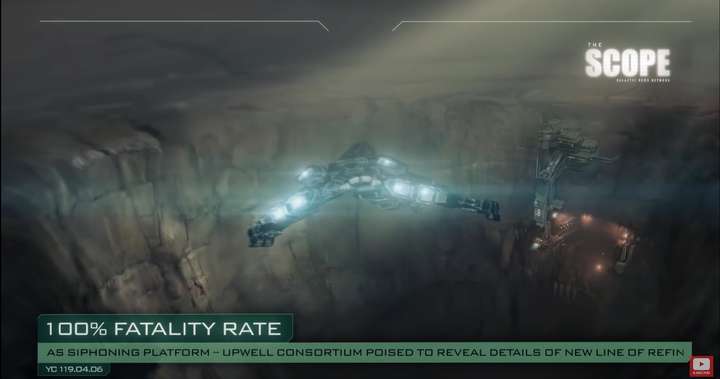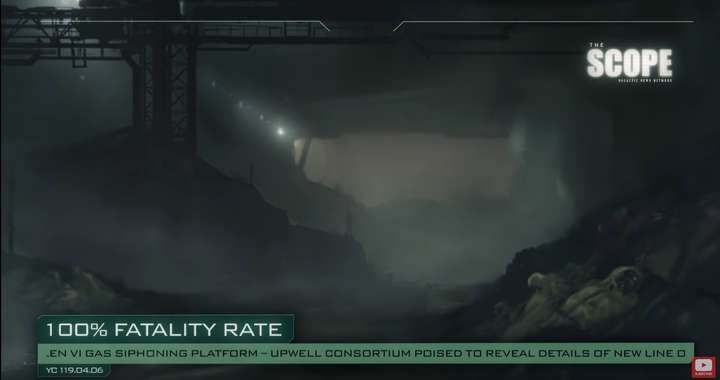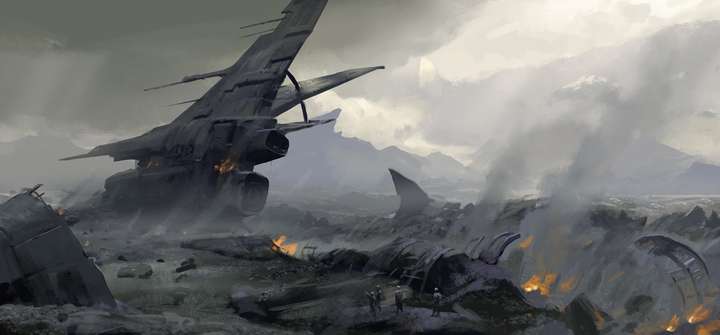
Galactic Hour News Roundup: Semiotic Shenanigans Edition
Caldari State Confirms that Special Security Measures in Taisy Remain Intact
Following a recent report of Guristas raiding activity in Taisy, notorious as the location of the "Kyonoke Pit", the Caldari State has responded to requests from the Scope's Galactic Hour with Ret Gloriaxx for information concerning the raid, the apparent presence of a CONCORD AEGIS division monitoring station, and the security situation in the system and on the Taisy VIII, Moon 1 Kyonoke site itself. Responding for the Chief Executive Panel, spokesman Odo Hakaalen said, "The CEP is satisfied that State authorities and involved megacorporation security forces have maintained the integrity of the Hyasyoda-Kyonoke Superconductors Mine Pit on Taisy VIII, Moon 1. Caldari Navy forces and Home Guard units operating under subcontracted authority were not involved in the recent Guristas incident. Requests for information on that matter should be directed to CONCORD." The Scope has thus far received no response to our requests to AEGIS or other CONCORD divisions for comment on the Taisy raid.




Deep in the Taisy system lies an inaccessible mining station called the Kyonoke Pit. The mine was built 40 years ago by a Caldari mining company, a subsidiary of the Hyasyoda Corporation. At the time, it was the largest TASC (Twin Atomic Superconductor Crystal). Ore mining and processing plant, and TASC is the main component of the manufacture of interstellar communication equipment.
Over the years, ore mining has developed steadily, and Jingnuo Mine has quickly become one of the most profitable mining stations in the Mishima Group. The Jingnuo mine is located on a huge asteroid. Over time, the mine has been dug deeper and deeper, even reaching the core of the planet.
Five years ago, the navigation tower orbiting the first star of Tais received an emergency signal from the Jingnuo mine: an infectious disease was spreading in the mining station, causing the workers to die in a short period of time. After a few minutes, the staff of the navigation tower lost contact with the mining station, and there was no follow-up communication access.

A reconnaissance ship was dispatched to investigate the situation. Upon arrival, they found the Jingnuo mine shaft shrouded in darkness and seemed to have no sign of life. The medical team put on protective clothing and entered the mine. They were stunned by the horrific sight in front of them. What caught their eyes were the bodies of miners scattered in all corners of the mine, some of which had begun to rot. The distressed expressions on the faces of the dead crew members were sufficient to show that they were in great pain before dying, and the bright red spots on their swollen bodies clearly indicated that they all died of poisoning or some kind of infectious disease. Apparently the lethal material spread all around in an instant, killing the entire crew within minutes.
Emergency medical teams reported their findings to the docked reconnaissance ship and continued to explore. A few hours later, the members of the medical team began to feel unwell, and the captain of the reconnaissance ship immediately ordered them to return to the ship quickly. But they collapsed on the way back, full of pain - apparently, even in protective suits, they couldn't escape the deadly infectious disease. The surviving medical team members desperately ran towards the spacecraft, but fell down one by one on the way. The captain, taking into account the safety of the rest of the crew, ordered an emergency departure, just as someone was struggling to climb up the docking ladder between the spacecraft and the ground. The spaceship roared and roared away.

Let's take a look at the infectious disease that occurred in the Jingnuo mine, one of the most mysterious and deadly infectious diseases that human beings have come into contact with. In the hours after the aforementioned incident, the Caldari blocked news about the Keino mine. Significant discoveries were made after further careful investigation. A protein-like biological particle has been identified as the culprit behind the outbreak. It enters the human body through breathing, then enters the blood circulation, and finally it invades the brain and grows rapidly, evolving to a higher state. This protein-like particle enters the medulla oblongata and rapidly infects nerve cells. At this point, the host will quickly lose all physiological functions, and will be accompanied by abnormal pain, and finally die of cardiopulmonary failure within a few minutes. Viruses can survive for days in the late stages of production, and after one host dies they attack organisms near the original host as new hosts, so that another victim will die hours later after the virus has invaded the brain.
The virus can dormant for several years in its primary state and can hide in extremely harsh environments. When it invades a living body, it usually transfers to a later advanced state, but sometimes it does not attack immediately, but lurks in the body for a long time. When it invades the brain, it will slow down in a few months. Slowly phagocytosing brain cells, people gradually die in the process. The dual nature of this biological particle is unpredictable and dangerous.
We can infer that this biological particle exists deep in the asteroid's core, and was brought back to light by an accidental mining operation at the Jingnuo mine. Did it originate in the place where it was discovered? There is no answer to this question yet. In fact, it is difficult to identify it at all, because it is so similar to ordinary protein. This makes us wonder if it originated from the body's own body cells, or even a man-made virus from a long time ago. Such an inference has not been confirmed, because the virus is extremely difficult to detect and the mortality rate of infected people is 100%, so both the military and terrorists have developed a strong interest in it and are eager to study it.

Now the space navigation tower of Tais Prime has been transformed into a super-large detection device, and Caldari is trying to find out about this mysterious biological particle through here. The Jingnuo mine was sealed and permanently isolated. Caldari patrol fleets patrol this day and night, prohibiting any unauthorized ships from approaching. A few years later, a group of unidentified persons drove two spaceships to infiltrate there successfully. They collected samples of the virus. Not only that, they also filled the cabin with TASC ore. When they made their way home, the robbers showed symptoms of a virus infection. One of the ships rammed into the Jingnuo mine, severely damaging the abandoned mining site, and the entire ship was almost destroyed. The other, although successfully escaped from the Caldari, vanished without a trace in an asteroid zone and has not been heard from since. The Kyno Mine is now surrounded by debris and dead bodies, making any ships cautious when approaching the area littered with mining rig debris. Since then, Caldari has adopted tighter security measures, and in the face of these, no one dares to touch the once-vibrant mining resort.
